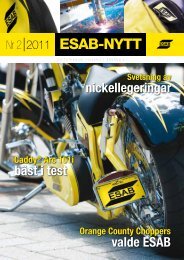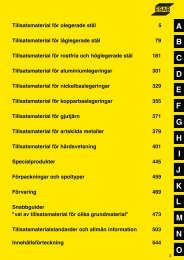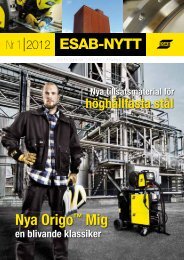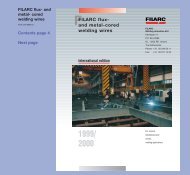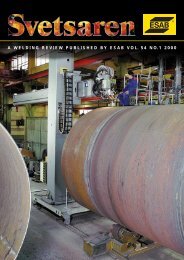Nya Svetsaren 1, 1999. - Luleå University of Technology
Nya Svetsaren 1, 1999. - Luleå University of Technology
Nya Svetsaren 1, 1999. - Luleå University of Technology
You also want an ePaper? Increase the reach of your titles
YUMPU automatically turns print PDFs into web optimized ePapers that Google loves.
nipulation for the adjustment <strong>of</strong>parts, elaborate positioning proceduresusing expensive, complicatedtools can be replaced bysimple tools and the final accuracywill be produced by laser adjustment[Table 1].It is clear that laser processingin the electronics industry has becomea mature technology and alarge number <strong>of</strong> parts can only bemanufactured using this technology[Fig. 5]. Using solid state laserswith high beam quality, it ispossible to create weld sizes inthe 100 µm range. By adaptingthe beam geometry and pulseshape for each individual weldingapplication, it is possible to minimizethe distortion as well as thecontamination <strong>of</strong> the welded part.Welding plasticsThe application <strong>of</strong> lasers hascreated new opportunities in thewelding <strong>of</strong> thermoplastic components,which until now has primarilybeen performed usingultrasonic or vibration welding.For this area <strong>of</strong> application,Nd:YAG and diode lasers, <strong>of</strong>feringradiation near a wavelength<strong>of</strong> 1 µm, are suitable for use because<strong>of</strong> the absorption characteristics<strong>of</strong> plastic materials. Theseabsorption characteristics in thematerials to be welded are veryimportant when using laser. Theabsorption and thereby the penetrationdepth <strong>of</strong> the radiation is afunction <strong>of</strong> the laser beam andmaterial composition. Plastic materialsabsorb the CO 2 radiationin the surface layer and cause thevaporisation <strong>of</strong> the material. TheNd:YAG and diode radiationpenetrates into the polymer sampleand produces a melting volumewhich is necessary for thewelding process. The absorptionproperties can be influenced bythe content <strong>of</strong> pigment in theplastic material. So black partscan be welded together, becausebeing black to the eye differsfrom being black or absorptivefor the laser.Virtually all thermoplastic materialscan be laser welded. Thejoining <strong>of</strong> two different materialsis possible if the material combinationis weldable, i.e. the temperatureranges in which the materialsare liquid must overlap.Fluorinated and temperatureresistantmaterials can be weldedwith lasers, as well as PMMA andABS, or plastic to metal. In acombination <strong>of</strong> increasing interestto the automotive industry,TPEs can easily be joined withthermoplastics using laser radiation[Fig. 6].A keyless entry product has ablack keypad overlap-weldedonto the black case [Fig. 7]. Thekeypad is coloured with a pigmenttransparent to laser radiation,while carbon is used as theabsorptive pigment for the case.Welding these keyless entry casesis the first example in which thelaser is being used in an industrialapplication. Laser welding waschosen because the keypad is thefinal part <strong>of</strong> the assembly and iswelded after all the electronic circuitsare mounted. Other weldingprocesses would have led to increasedscrap rates. Ten diode laserswith an output power <strong>of</strong> 30W each are used to perform thewelding process and the weldingspeed is in the range <strong>of</strong> 5 m/min.Using the laser also permits excellentquality control <strong>of</strong> the weldseam during production. Modernelectronics and sensor technologyprovide the means for on-linemonitoring and process control <strong>of</strong>Figure 8: Principal layout <strong>of</strong> a diode laser bar for an HPDL.Figure 6: Diode laser welded specimens<strong>of</strong> TPE/thermoplastics.Figure 7: Laser welded polymer keycasing with integrated electronic components.48 <strong>Svetsaren</strong> No.1–2 1999



